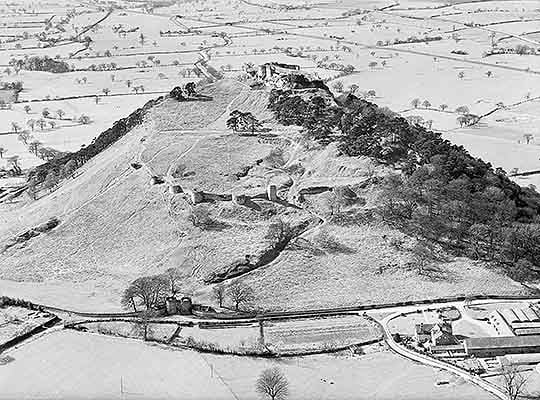Research on Beeston Castle
Much early work on the castle’s medieval history was concerned with the long-standing myth that Richard II (r.1377–99) placed treasure in the inner ward well, rather than on the structural history of the building. Although historical sources suggest that any stockpiles of treasure were recovered by Henry IV (r.1399–1413), the legend was probably the reason for systematic investigations of the castle well in 1794 and 1842.

The Medieval Castle in Context
The first serious academic attempt to put the building into a broader context was made in 1959.[1] A short but valuable account, chiefly of the castle under royal ownership, was published in 1963 in the History of the King’s Works.[2]
Published editions of the primary sources for the castle in the 13th and 14th centuries appeared throughout the 20th century, in particular references collated by R Stewart-Brown.[3] The publication in 1991 of the Chamberlain of Chester’s account of 1361–2 added to our knowledge of the building works at this time..[4]
The Civil War
The Civil War in Cheshire has been a fruitful subject of research for historians since the late 19th century. Important sources for the Civil War reuse of the castle were published in 1889,[5] with RN Dore adding substantially to the military history in 1965–6.[6]
Dore also published valuable primary material written by the Parliamentarian Sir William Brereton.[7] This Civil War material was reviewed and reinterpreted by J Barratt in 1995.[8]
Excavations
Arguably the most significant work on Beeston since 1945 has come from archaeology. Before making the site publicly accessible the Ministry of Works supervised clearance of the rock-cut ditch between the inner and outer wards, and two series of excavations were carried out, in 1968–73 and 1975–83.[9]
This work transformed the history of the site, revealing the prehistoric origins of the defences. As a result, Beeston Castle is now relatively well documented and there is now a body of archaeological evidence for the early history of the crag.
Reconstructing a Bronze Age roundhouse
In 2019 a team of volunteers reconstructed a Bronze Age roundhouse in a former quarry within the castle grounds.
Taking the pattern of archaeologically excavated postholes from one of the original roundhouses as a starting point, the team designed a building with 12 outer wall posts and three tall central posts, all supporting horizontal wall-plate timbers. The rafters rise from the outer circle of wall-plates to meet the higher inner plates. To build the roundhouse the team used local materials that would have been available in the Bronze Age, including oak for the main posts and hazel and ash for the walls and roof.
Areas for future research
There are a number of areas where future research might illuminate aspects about the castle’s history:
Anglo-Saxon Beeston
The absence of occupation on the crag from the Roman period to the 13th century seems at odds with the otherwise long history of the site, but this ‘abandonment’ may be more apparent than real.
Paleobotanical evidence suggests the regeneration of woodland on the crag in the Saxon period and it is worth speculating whether this woodland was connected with a place of pagan worship. Study of place names and field names might contribute information here.
Folklore and Legend
The study of local names, traditions and stories might help in building up a picture of Beeston’s place in local folklore – in particular the myth of Richard II’s treasure, and the 16th-century prophecy that the castle would one day save England. Recovering and fleshing out local traditions and stories about Beeston would shed important light on non-elite perceptions of the castle and its landscape.
Landscape Studies
It would be useful to know if the crag represents the most visible point in the landscape or is one of a number of places where such a visual effect could have been created. The use of Geographical Information Systems (GIS) techniques, now commonplace in archaeology, allows the inter-visibility of points in the landscape to be accurately measured.
Another important question is whether the decision to occupy the crag in prehistory was driven simply by the needs of metalworking, owing to the mineral deposits located there, or whether the perceived benefits of an elevated location prompted its use for human activity.
Beeston’s role in the landscape of the 19th-century Peckforton estate created by John Tollemache would also repay further study. It is possible that detailed records of the repairs to the medieval castle are contained within the Victorian building accounts for Peckforton, and so would indicate the nature and scale of these works.
READ MORE ABOUT BEESTON CASTLE
Footnotes
1. MH Ridgway and DJ King, ‘Beeston Castle, Cheshire’, Journal of the Chester and North Wales Architecture, Archaeology and History Society, 46 (1959), 1–23.
2. RA Brown, HM Colvin and AJ Taylor (eds), The History of the King’s Works, vol 2: The Middle Ages (London, 1963).
3. R Stewart-Brown (ed), Accounts of the Chamberlains and Other Officers of the County of Cheshire, 1301–1360, Lancashire and Cheshire Record Society, 59 (1910); R Stewart-Brown (ed), Cheshire in the Pipe Rolls, Lancashire and Cheshire Record Society, 92 (1938).
4. PHW Booth and AD Carr, Account of Master John de Burham the Younger, Chamberlain of Chester, of the Revenues of the Counties of Chester and Flint, Michaelmas 1361 to Michaelmas 1362, Lancashire and Cheshire Record Society, 125 (1991).
5. J Hall (ed), Memorials of the Civil War in Cheshire, Lancashire and Cheshire Record Society, 19 (1889; accessed 10 October 2014).
6. RN Dore, ‘Beeston Castle in the Great Civil War, 1643–46’, Transactions of the Lancashire and Cheshire Antiquarian Society, 75–6 (1965–6), 3–22.
7. RN Dore, The Letter Books of Sir William Brereton, vols 1 and 2, Lancashire and Cheshire Record Society, 123 (1984) and 128 (1990).
8. J Barratt, Civil War Stronghold: Beeston Castle at War 1642–5 (Birkenhead, 1995).
9. P Ellis, Beeston Castle, Cheshire: Excavations by Laurence Keen and Peter Hough, 1968–85, English Heritage Archaeological Report 23 (London, 1993).